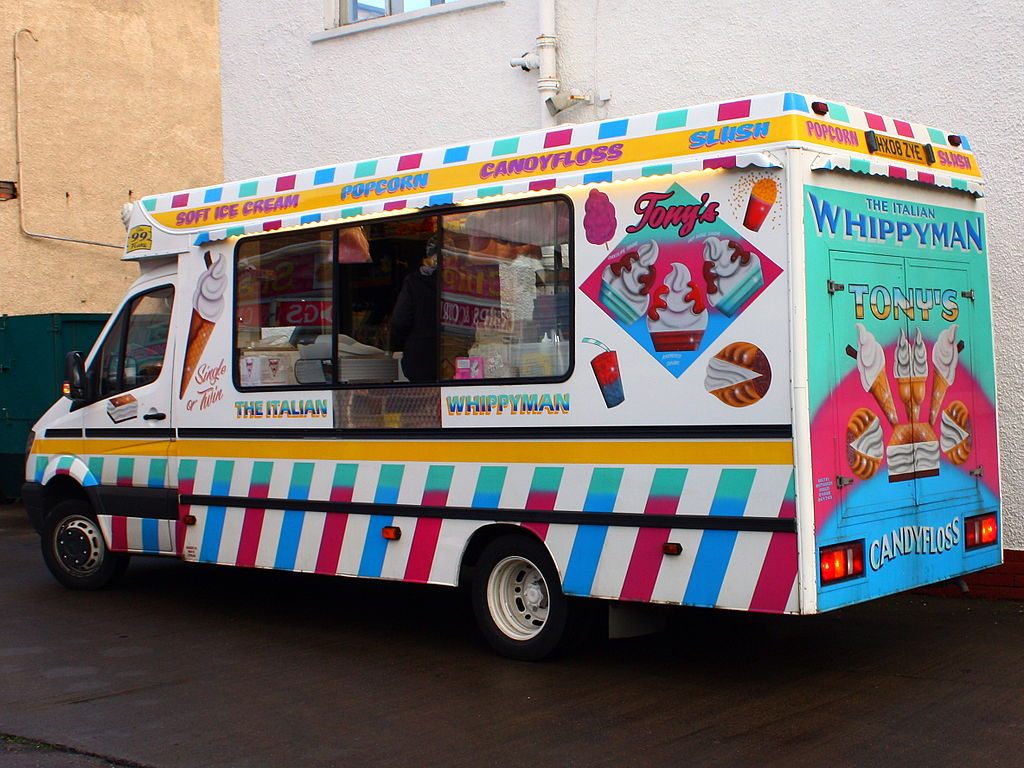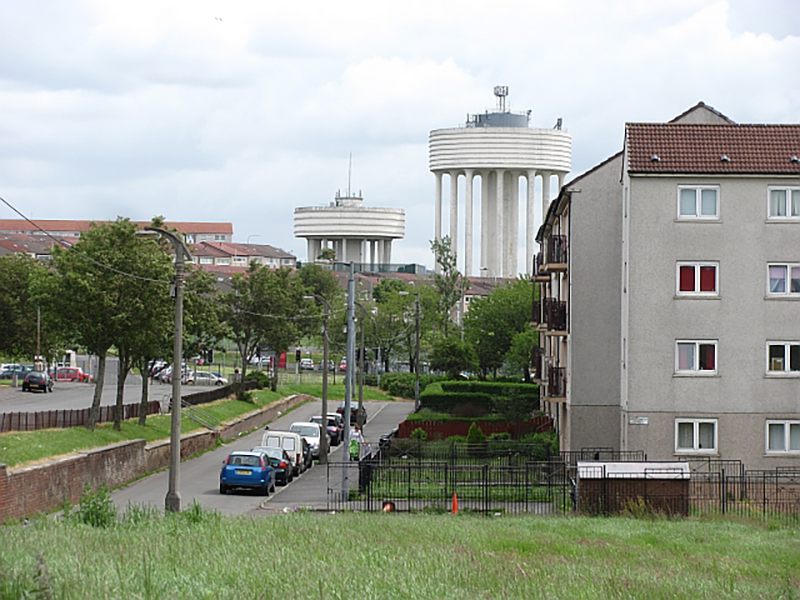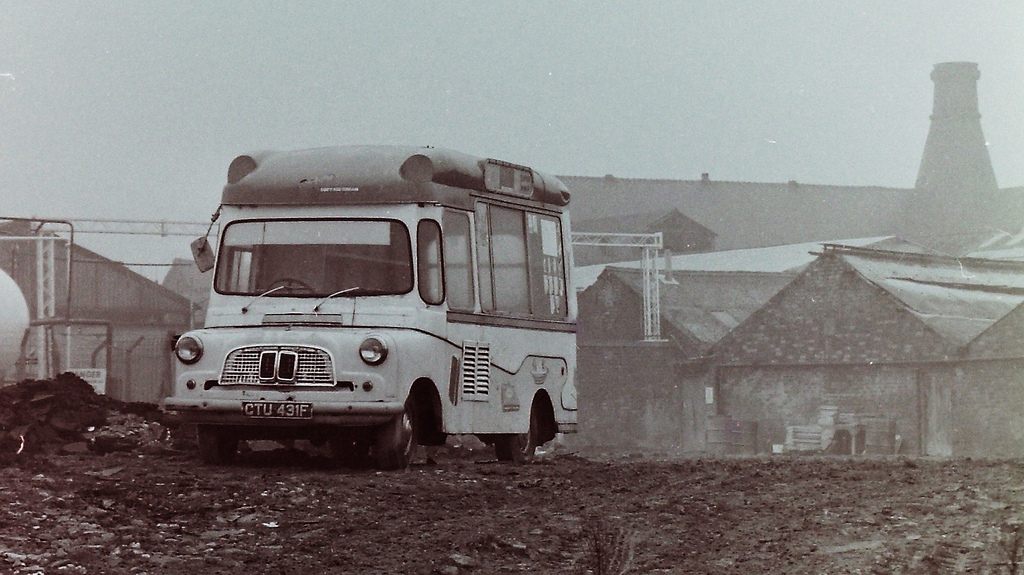The Violent Ice Cream Wars of 1980s Scotland
The most dangerous job in Glasgow was being an ice cream man.

An ice-cream van in Scotland. (Photo: Andy Mitchell/CC BY-SA 2.0)
In Glasgow, Scotland, during the 1970s and ’80s, people in public housing might have heard the music-box-like song of Greensleeves drifting from the vehicle of everyone’s favorite summer hero, the ice cream man. But it was best to resist the siren call of those cold, sweet treats. That’s because ice cream men at the time were handing out more than sugar highs. They were feuding with rival ice cream trucks over territory, often violently, and buying an ice cream cone on a hot day could be dangerous.
Mobile ice cream businesses have a surprisingly long history of illegal activity, hiding in plain sight; even recently, in 2013, police arrested an ice cream man in New York City for using his business as a front to sell painkillers and cocaine. These activities often end in arrests, but the illegal activities of ice cream men in Glasgow were more extreme, involving whole neighborhoods in territorial gang battles. During this era, known now as the Glasgow Ice Cream Wars, the news was filled with scoops of ice cream-related violence.
“Mafia-style warfare broke out when two brothers decided to muscle in on an ice cream monopoly controlled by two families,” read the Glasgow Herald in 1979, in a story detailing how two brothers, both ice cream men, had attacked a rival ice cream van with bricks and planks of wood, and caused a mob scene.

Ruchazie, north-east Glasgow. (Photo: Richard Webb/CC BY-SA 2.0)
The site of these battles was the Glasgow housing schemes (similar to housing projects in the U.S.), which were mostly built in the 1960s to replace the old and dangerous tenement housing. The schemes were made for low-income families, and the amount of money going into the schemes died off once people moved in; they were built on the outskirts of the city, and often lacked access to basic shops and grocery stores.
Ice cream van businesses had been well-established in the area for decades, so to make up for the lack of shops, vans popped up as traveling stores to supply the schemes with much-needed goods. They sold groceries, toilet paper, and other things people sorely needed but couldn’t get nearby, but primarily advertised ice cream. This became a profitable niche for the time; some reports say an ice cream van could earn a profit of 200 pounds per week. Eventually, ice cream vans were also routinely selling drugs and stolen property. Of course, they also still sold popsicles and ice cream sandwiches, and played merry little melodies as they made the rounds.
These van companies declared claims over different areas surrounding the housing schemes. If you tried to sell ice cream or anything else in an area you didn’t have the “rights” to, you faced violence. In an episode of the BBC investigative series Trial and Error, which looked into a court case related to the ice cream wars, a “convicted van smasher” recalls that ice cream van gangs used rocks, knives, axes—anything to defend their mobile drugs and treat vans.

An old ice cream van in Staffordshire, England. (Photo: stevep2008/CC BY 2.0)
The ice cream gang wars frequently ended up in Glasgow crime blotters. Even a summer job as a server could put you in danger: On September 9, 1989, The Glasgow Herald reported that while serving ice cream in a van, an 18-year-old was shot in the shoulder and permanently disabled by a 23-year-old ice cream gang member, who felt so guilty he attempted suicide over the incident. In 1986 one ice cream van was robbed by two young men with “a plastic bag of two revolvers in it”; they planned to “damage ice-cream vans in Castlemilk,” a district of Glasgow.
By 1984, the violence had graduated to murder. Ice cream man Andrew “Batboy” Doyle infringed on someone else’s territory, and allegedly refused to back away or sell merchandise for the dominant gang’s vans. Another van company began intimidation tactics against Doyle. When the standard glass-breaking and threats didn’t drive him away, they started a fire at his house that ended in the deaths of Doyle and five members of his family, including an infant.
The police and public response to these murders were frantic, and the ice cream wars became central to one of Scotland’s most notorious miscarriages of justice. Desperate to make a conviction, police coordinated a plea bargain with jailed ice cream van robber John Love, who implicated ice cream van owners Thomas “TC” Campbell and Joe Steele as the culprits. When arresting Campbell and Steele as suspects, the police claimed to hear each man make separate incriminating statements referencing the crime, which were later criticized for being unlikely and possibly fabricated. Both Campbell and Steele maintained their innocence, but the utterances were considered evidence enough to sentence them to prison for a minimum of 20 years.
Campbell went on several hunger strikes in prison, while Steele escaped three times to protest the conviction with public stunts, including supergluing his body to the outer gates of Buckingham Palace in 1993. In 1992, Love had confessed that his original statement to the police had been invented; this and a series of appeals led to a reexamination of the case in 2001. Campbell and Steele were finally set free in 2004. The original arsonists were never found.

Glasgow’s ice-cream wars continued through the 1980s. (Photo: Leon Brocard/CC BY 2.0)
A decade after getting out of prison, Campbell told a Trial and Error journalist that he had regrets about the bizarre violence of the ice cream gang wars. “A lot of my friends were killed… I was near to death on a few occasions myself,” Campbell said. “I’ve been caught with axes, I’ve been caught with swords, open razors, every conceivable weapon… meat cleavers… and it was all for nothing, no gain, nothing to it, just absolute madness.”
In news stories about the violence, most of the people involved seemed like Campbell had once been, desperate and young, and usually under the age of 26; the ice cream was incidental. The ice cream wars continued for a few more years in the housing schemes, with minor acts of revenge mentioned in The Glasgow Herald throughout the 1980s. Eventually, though, the ice cream van business stopped being lucrative in Glasgow, thanks to the availability of ice cream at newer corner stores, though the occasional ice cream vendor scuffle still occurs.
Today, the mobile ice cream business is in serious decline, with just a few thousand ice cream trucks left in the U.K. Many housing schemes have banned the once-ubiquitous chiming vans, but this is largely due to concerns about childhood obesity and noise pollution, not ice cream men attacking each other. People who remember the Glasgow Ice Cream Wars likely view this ban with relief.
Gastro Obscura covers the world’s most wondrous food and drink.
Sign up for our regular newsletter.
























Follow us on Twitter to get the latest on the world's hidden wonders.
Like us on Facebook to get the latest on the world's hidden wonders.
Follow us on Twitter Like us on Facebook